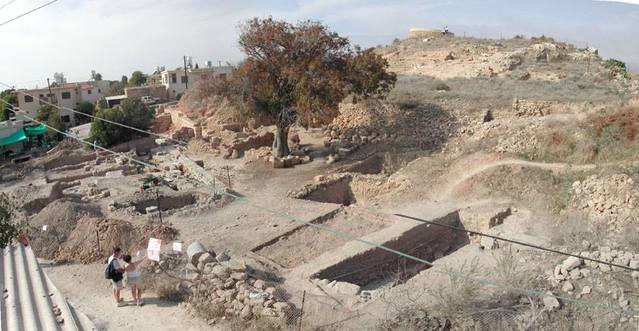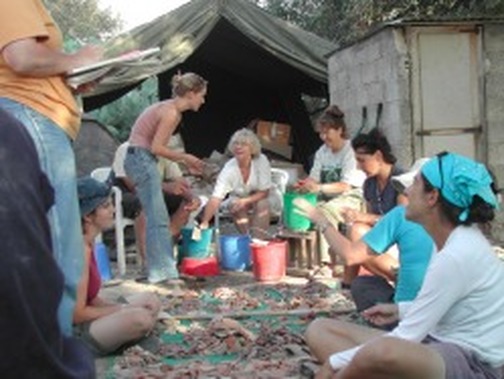The University of Sydney Paphos Theatre Excavations, Cyprus:
|
by Dr Craig Barker.
First published: The AAIA Newsletter, December 2002, 26-27 |
 A general view of the site from the roof of one of the dig houses.
A general view of the site from the roof of one of the dig houses.
Between 6 October and 19 November 2002, a team of professional archaeologists, students and contributing volunteers from the Department of Classical Archaeology at the University of Sydney, led by Professor Richard Green, conducted its seventh season of excavations at the site of the ancient theatre in Nea Paphos, Cyprus.
The site of the theatre is located on the south slope of Fabrika Hill, a small hill overlooking the World Heritage listed settlement of Nea Paphos. Here, a theatre was partially carved out of the bedrock of Fabrika hill, and partially constructed on earthen embankments, shortly after the foundation of the settlement of Nea Paphos late in the fourth century BC. This theatre was to be a focal point for the ancient community of Nea Paphos for over six hundred years, undergoing several phases of modification and rebuilding, particularly during the Roman occupation of the island. Following a series of catastrophic earthquakes and general changes in attitude towards performance in the newly Christianised Roman Empire of the late fourth century AD, the theatre finally fell into disuse. The stone and marble from the theatre and from associated buildings were heavily quarried in the fifth century AD, before' the site was completely abandoned. Many centuries later the site was used for domestic, agricultural and small-scale industrial purposes, as attested by at least one significant recovered building of the Medieval and Ottoman periods constructed over the orchestral area.
The 2002 season was very successful, with a large area of the orchestra and stage building excavated in the period of six weeks. Additionally, significant remains of the later occupation on the site were recovered including a number of rooms of the medieval building mentioned above seemingly based around a large courtyard. This structure will receive more detailed study in the near future. Considerable Ottoman period pottery and pipes were also recovered from higher deposits in the area indicating that this structure was rebuilt and reused over a considerable period. Two small ovens were excavated within its walls and it seems that they too date to the late phases of the building.
The site of the theatre is located on the south slope of Fabrika Hill, a small hill overlooking the World Heritage listed settlement of Nea Paphos. Here, a theatre was partially carved out of the bedrock of Fabrika hill, and partially constructed on earthen embankments, shortly after the foundation of the settlement of Nea Paphos late in the fourth century BC. This theatre was to be a focal point for the ancient community of Nea Paphos for over six hundred years, undergoing several phases of modification and rebuilding, particularly during the Roman occupation of the island. Following a series of catastrophic earthquakes and general changes in attitude towards performance in the newly Christianised Roman Empire of the late fourth century AD, the theatre finally fell into disuse. The stone and marble from the theatre and from associated buildings were heavily quarried in the fifth century AD, before' the site was completely abandoned. Many centuries later the site was used for domestic, agricultural and small-scale industrial purposes, as attested by at least one significant recovered building of the Medieval and Ottoman periods constructed over the orchestral area.
The 2002 season was very successful, with a large area of the orchestra and stage building excavated in the period of six weeks. Additionally, significant remains of the later occupation on the site were recovered including a number of rooms of the medieval building mentioned above seemingly based around a large courtyard. This structure will receive more detailed study in the near future. Considerable Ottoman period pottery and pipes were also recovered from higher deposits in the area indicating that this structure was rebuilt and reused over a considerable period. Two small ovens were excavated within its walls and it seems that they too date to the late phases of the building.
 Members of the excavation team at work on the finds
Members of the excavation team at work on the finds
Elsewhere, extensive excavation of the western parodos (entrance-way) has cleared this section of the ancient theatre. It is now possible to walk on part of its original third century AD surface. A mysterious large cut through the floor of the parodos was filled with Hellenistic period pottery; the purpose of this cut is unknown and will be investigated in detail next season. A considerable number of painted plaster fragments of the mid-second century AD were also recovered from this area; they came from the analemma wall of the parodos. Indeed there are still some painted pieces attached to the western analemma wall, relatively rare finds from surviving ancient theatres and extremely important archaeological evidence of decoration of public buildings. For the first time, a relatively long section of the eastern analemma wall was also cleared this season. Although not as well preserved as its western counterpart, more clearance of this area in the future should reveal the eastern parodos as well. Now that the excavation has established the outline of the cavea of the theatre it is possible to establish its seating capacity to about 8000 spectators. This capacity makes it one of the largest theatres in ancient Cyprus.
The Department of Antiquities began work on the removal of the upper levels of soil fill covering the semi-circular area of the cavea, the lower part of which will be excavated manually in the next season so that the seating carved into the bedrock is completely revealed. Restoration and recreation of the seating is expected to begin shortly after its excavation is concluded. It is hoped that eventually the restored theatre can be used again for performances. The 2002 excavations revealed a large range of ceramic, glass and metal finds particularly of the Late Roman, Medieval and Ottoman periods. Considerable progress was made in many aspects of the research of the site. Three important areas should, however, be highlighted: the contribution of the excavations towards a greater understanding of local production of medieval glazed ceramics from the 12th to the 15th centuries, the function and use of ceramic cooking vessels through time and their evidence for changes in dietary patterns from Hellenistic to Ottoman Cyprus, as well as the study of the range and provenance of marble architectural fragments found on the site. The study of these three areas and other aspects of the research of finds will make a substantial contribution to the understanding of the history and archaeology of Classical and post -classical Cyprus.
While there were many significant individual fids in 2002, perhaps the most important of the discoveries from the season was a large marble slab bearing part of an inscription. The marble slab had been reused and placed face down as a threshold between the western parodos and the orchestra during modifications to the theatre in the third century AD. Once the slab was lifted in October, part of an inscription recording the dedication and rebuilding of the theatre by the emperors Antoninus Pius and Marcus Aurelius of the mid-second century AD was revealed. The find matches a marble inscription already held in the Paphos Museum, and together they represent an important epigraphic and chronological indicator of the political and cultural significance of the theatre in ancient Nea Paphos.
The 2002 team was the project's largest ever with over 90 people in total participating in the excavations in some way. A series of instructive public tours of the site and seminars on aspects of the research and work were held, and our annual barbeque was a huge success with over 100 guests participating. The team also attended a range of cultural events in Paphos and assisted local archaeologists with excavations of other nearby sites. As always, the excavations enjoyed a close working relationship with the Department of Antiquities of Cyprus and the Municipal Council of Paphos. The work on writing-up of the material from the excavations continues in earnest with a number of papers related to various aspects of the team's work to be published in 2003-2004. A number of postgraduate dissertations on the project are nearing completion and significant progress is being made towards the publication of a substantial report.
The Department of Antiquities began work on the removal of the upper levels of soil fill covering the semi-circular area of the cavea, the lower part of which will be excavated manually in the next season so that the seating carved into the bedrock is completely revealed. Restoration and recreation of the seating is expected to begin shortly after its excavation is concluded. It is hoped that eventually the restored theatre can be used again for performances. The 2002 excavations revealed a large range of ceramic, glass and metal finds particularly of the Late Roman, Medieval and Ottoman periods. Considerable progress was made in many aspects of the research of the site. Three important areas should, however, be highlighted: the contribution of the excavations towards a greater understanding of local production of medieval glazed ceramics from the 12th to the 15th centuries, the function and use of ceramic cooking vessels through time and their evidence for changes in dietary patterns from Hellenistic to Ottoman Cyprus, as well as the study of the range and provenance of marble architectural fragments found on the site. The study of these three areas and other aspects of the research of finds will make a substantial contribution to the understanding of the history and archaeology of Classical and post -classical Cyprus.
While there were many significant individual fids in 2002, perhaps the most important of the discoveries from the season was a large marble slab bearing part of an inscription. The marble slab had been reused and placed face down as a threshold between the western parodos and the orchestra during modifications to the theatre in the third century AD. Once the slab was lifted in October, part of an inscription recording the dedication and rebuilding of the theatre by the emperors Antoninus Pius and Marcus Aurelius of the mid-second century AD was revealed. The find matches a marble inscription already held in the Paphos Museum, and together they represent an important epigraphic and chronological indicator of the political and cultural significance of the theatre in ancient Nea Paphos.
The 2002 team was the project's largest ever with over 90 people in total participating in the excavations in some way. A series of instructive public tours of the site and seminars on aspects of the research and work were held, and our annual barbeque was a huge success with over 100 guests participating. The team also attended a range of cultural events in Paphos and assisted local archaeologists with excavations of other nearby sites. As always, the excavations enjoyed a close working relationship with the Department of Antiquities of Cyprus and the Municipal Council of Paphos. The work on writing-up of the material from the excavations continues in earnest with a number of papers related to various aspects of the team's work to be published in 2003-2004. A number of postgraduate dissertations on the project are nearing completion and significant progress is being made towards the publication of a substantial report.